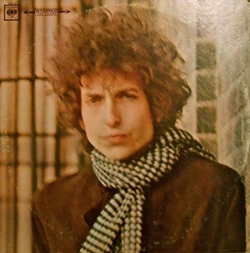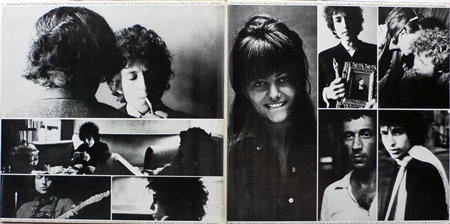 Bob Dylan: Blonde On Blonde (Columbia)
Bob Dylan: Blonde On Blonde (Columbia)
It is almost impossible to write about this album. Wherever you are in life, wherever you came from, the road goes through “Blonde On Blonde”. Released just days before Dylan disappeared behind a smoke screen of stories about a fatal motorcycle accident up in Woodstock. Maybe fatal, or maybe just some scratches, it is irrelevant. Dylan had to disappear. He had gone all the way. Beyond the 1966 tour and this double album there was nothing, just a dark horrifying abyss.
The anguished man who is sharing a taxi with John Lennon in the morning hours of May 1st in London, 1966 (check out the “Eat The Document” movie on youtube.com) is burned out, cast out, exhausted, reviled, and on the brink of disintegration. He had redefined rock music by delivering the three masterpieces “Bringing It All Back Home,” “Highway 61 Revisited” and “Blonde On Blonde”. Now he was paying the price.
The latter album, not yet released on that May morning in 1966, is also the greatest, if one dares to rank them. “Blonde On Blonde” is a traveling carnival of Americana populated by enigmatic, shadowy characters that move in the dim glimmer of light, sometimes disappearing into the darkness, half surreal, half-recognizable. There is humor here and unparalleled beauty, blues soaked in tears and blood, wheezing putdowns and cheering speed-trips, and at the heart of the songs, behind the burlesque pictures, are shifting glimpses of Dylan himself, at that time perhaps the loneliest soul in the world, wonderfully kneeling at the feet of his muse Sara in the album’s swaying finale, “Sad Eyed Lady Of The Lowlands”.
Musically, the album is warmer and more varied than its predecessors. Mostly recorded in Nashville with prolific session musicians who were used to playing with country music’s greatest. Dylan’s working methods took them completely by surprise. His aversion towards multiple takes confused them of course, but even worse was the fact that he could arrive in the studio with only half finished tunes, finishing the lyrics in a corner by himself and then putting the band to work without any run through at all.
During the recording of “Sad Eyed Lady Of The Lowlands” they had to guess when the song drew to a close, being familiar with three minute tunes they pushed on with bravado each time they approached the final lines of the chorus only to find themselves back at the beginning entering yet another verse. It went on forever, and every refrain sounds like an electrical, high voltage finale. It is a remarkable recording bringing out the best in these confused, but stellar musicians. What an ensemble!
Musically, “Blonde On Blonde” is an extraordinarily rich tapestry. There’s the kick-off track, the slide tromboned Salvation Army pastiche “Rainy Day Women Nos. 12 & 35” (how the enthusiastically inviting “Everybody must get stoned!”-line got passed the censors is a mystery to me). There’s deep dives into the electric blues like “Pledging My Time”, there’s the fingerpicking slap on Lennon’s hand “4th Time Around” (takes the mickey out of “Norwegian Wood”), there’s the mock tender break-up song “One Of Us Must Know (Sooner Or Later)” that hits naked nerves with its wonderfully caustic lines (“I didn’t mean to make you so sad, you just happened to be there, that’s all”) delivered in an epic whoosh of keyboards.
Dylan achieves the impossible when he merges surrealism with a happy go lucky pop-tune in “I Want You” (it skips and dances across the surface like your ultimate no. 1 hit), then mixes salt with sugar in the equally commercial, bittersweet and mysterious “Just Like A Woman”.
 The inside album cover of “Blonde on Blonde”.
The inside album cover of “Blonde on Blonde”.
The album is generous on epic or semi-epic songs; some of the strongest contenders are the enigmatic, fascinating “Stuck Inside Of Mobile With The Memphis Blues Again” and “Visions Of Johanna”. “Blonde On Blonde” signs off with the best of them all, “ Sad Eyed Lady Of The Lowlands “, which could easily have lasted hours and not just 11 minutes and 23 seconds.
“Blonde On Blonde”s warmth and sonic depth belies its contents because it is not a friendly record. The lyrics are sarcastic, sometimes very caustic, they wear a poisonous smirk and they are stuffed with sharp one-liners cooked up by a vengeful and tired brain on fire.
You could make a living out of selling T-shirts with slogans like “To live outside the law you must be honest”, “ I never asked for your crutch, now don’t ask for mine”, “Pain sure brings out the best in people, doesn’t it?” and “You just sit around and ask for ashtrays, can’t you reach?”. And some did. (The last two quotes by the way are from “She’s Your Lover Now”, a lost classic, never properly recorded, that was left off “Blonde On Blonde”.)
In retrospect there’s a highly noticeable blue light shining all through the album that was not so easy to spot at the time. “Blonde On Blonde” is a magnificent and powerful, but also necessary end to a chapter in Dylan’s life as an artist. He had to head down into the basement with The Band at Woodstock to reclaim himself and search for another path, he had gone the previous one to its very end.
“Blonde On Blonde” was not released in May 1966 even if most discographies claim so. CBS planned to release it then, and the date given in their pre-release sheets is probably the reason for the mistake. However the album did not appear in the Billboards Album Chart until July 23, 1966, and as a record took a couple of weeks to register. The most probable release date is the first week of July.
In the UK (and Europe) it wasn’t released until August, the week after The Beatles’ “Revolver”. This fact is interesting when you listen to “The Bootleg Series Vol 4: Bob Dylan Live 1966” (recorded in Manchester on May 17, 1966). The audience actually heard “4th Time Around”, “Visions Of Johanna”, “Just Like A Woman “(all in acoustic versions) and “Leopard-Skin Pill-Box Hat” (electric) for the first time in that evening. The only “Blonde On Blonde”-tracks they did know were “Rainy Day Women Nos. 12 & 35” (shortened version) / “Pledging My Time” (just released as a single), and “One of Us Must Know (Sooner Or Later) “ (released as a single in February 1966). He played none of these live.
Then he went home. Then came “Blonde On Blonde”. Then he disappeared. Finally, in December 1967, he reappeared with “John Wesley Harding”. A completely different musical and lyrical statement, and the beginning of a new phase. He would never again create anything similar to what he left behind.
Released: July 1966
(All songs written by Bob Dylan)
Side One
“Rainy Day Women o&12 & 35” – 4:36
“Pledging My Time” – 3:50
“Visions of Johanna” – 7:33
“One of Us Must Know (Sooner or Later)” – 4:54
Side Two
“I Want You” – 3:07
“Stuck Inside of Mobile with the Memphis Blues Again” – 7:05
“Leopard-Skin Pill-Box Hat” – 3:58
“Just Like a Woman” – 4:52
Side Three
“Most Likely You Go Your Way (And I’ll Go Mine)” – 3:30
“Temporary Like Achilles” – 5:02
“Absolutely Sweet Marie” – 4:57
“4th Time Around” – 4:35
“Obviously 5 Believers” – 3:35
Side Four
“Sad Eyed Lady of the Lowlands” – 11:23
The personnel involved in making Blonde on Blonde are subject to some discrepancy. Let’s option for this list:
Bob Dylan – vocals, guitar, harmonica, piano
Additional musicians:
Bill Aikins – keyboards
Wayne Butler – trombone
Kenneth A. Buttrey – drums
Rick Danko or Bill Lee – bass guitar (New York)
Bobby Gregg – drums (New York)
Paul Griffin – piano (New York)
Jerry Kennedy – guitar
Al Kooper – organ, guitar
Charlie McCoy – bass guitar, guitar, harmonica, trumpet
Wayne Moss – guitar, vocals
Hargus “Pig” Robbins – piano, keyboards
Robbie Robertson – guitar, vocals
Henry Strzelecki – bass guitar
Joe South – bass guitar, guitar
Technical personnel:
Bob Johnston – production
Jerry Schatzberg – cover photographer
First published in Pattaya Mail on May 30, 2013
 |
 |
 |





